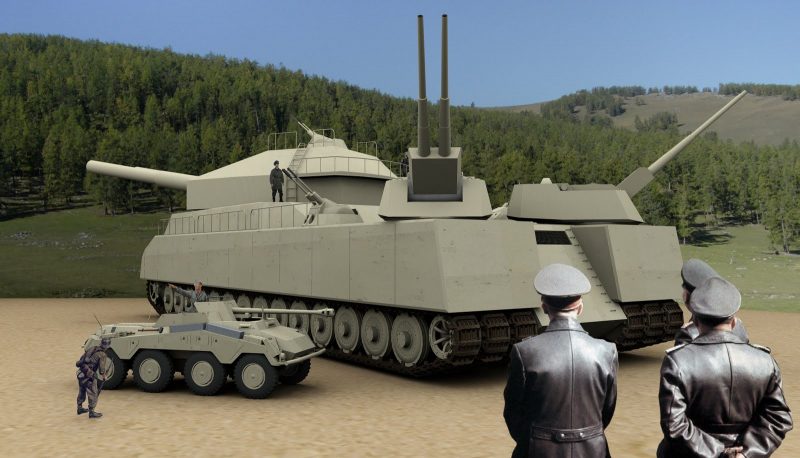As the beginning of the war swept over Europe, with lightening speed, Hitler felt invincible, at least for the first two years of the war. He was known for his megalomaniac ambitions, but the most telling example of his unrestrained hubris was endorsing the Landkreuzer P.1000, which he nicknamed The Rat (Ratte).
It was supposed to be more than five times heavier than its predecessor, Panzer VIII Maus, a super tank, built in late 1944. About 1,000 metric tons was the predicted weight, 35 meters long, 11 meters high and 14 meters wide it was to be the biggest land war machine ever created.
Its name, Landkreuzer (meaning land cruiser), implied a certain blend of naval ship adjusted to ground use. It was intended to use two 280 mm SK C/28 naval guns. Its engine was to be a dual MAN V12Z32/44 24-cylinder marine diesel engine of 12,600 kW or eight Daimler-Benz MB 501 20-cylinder marine diesel engines of 1,500 kW (2,000 hp) each (as used in E-boats) to achieve the 12,000 kW (16,000 hp) needed to move this tank. The engines were to be provided with snorkels, also like those used by German submarines.
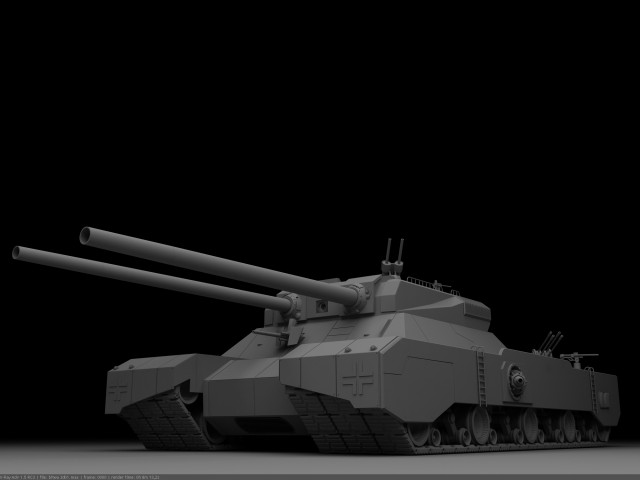
Artist impression [via]
The snorkels were designed to provide a way for oxygen to reach the engine, even during amphibious operations passing through deep water. In addition to Rat’s firepower was the 25 cm thick armor made out of hardened steel. The armor alone was predicted to weigh 200 tons. The gun turret was to be the modified version of the one used on the German capital battleship, Gneisenau.
The modification included removing the third gun and its associated loading mechanism from the naval turret and putting the gained space to use by providing extra accommodation for ammunition for the tank. The removing of the third gun and the loading system that it included would reduce the tank’s total weight by 50 tons.
The guns used for the Ratte would have fired ammunition developed for other naval guns. It also included armour-piercing rounds with 8.1 kg of explosive filler and high-explosive rounds with 17.1 kg of explosive filler.
Besides its primary guns, the Landkreuzer was to include a 128 mm anti-tank gun of the type used in the Jagdtiger or Maus, two 15 mm Mauser MG 151/15 autocannons, and eight 20 mm Flak 38 anti-aircraft guns, probably with at least four of them as a Flakvierling quad mount. Its firepower was to be uncomparable to anything the Allies had to offer.
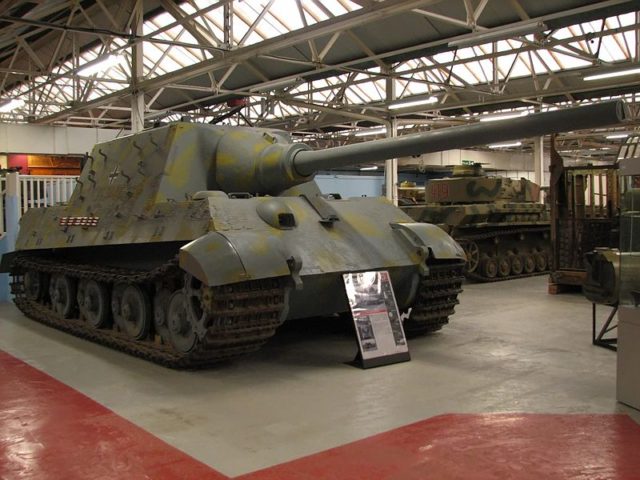
Due to the lack of preserved designs and the fact that the tank never produced a prototype, historians debate over the exact location of the 128 mm anti-tank gun, whether it was supposed to be mounted on the primary turret, or did it demand an another, smaller turret to be added as a vital component. Furthermore, the Landkreuzer was planned to contain a vehicle bay that could hold two BMW R 12 motorcycles used for scouting activities.
The idea was suggested to Hitler by the director of the Krupp company, Edward Grotte. These were the same guys who blessed the world with ridiculously large siege cannons such as Big Bertha and Long Max, which proved to be terrifying in WWI, but their successors became easy prey for bombers in WWII.
So, for the Krupp company big meant effective and Hitler shared their opinion, even though his trusted associate, Albert Speer, who was the Minister of Armament and War Production, didn’t. The design and the idea of a tank so large it could be considered a ship on land came from studying the Soviet competition.
Stalin was also a known megalomaniac who introduced KV 1 and KV 2 which were both known to turn the outcome of a battle. Also, the Germans were acquainted with the KV VI project.
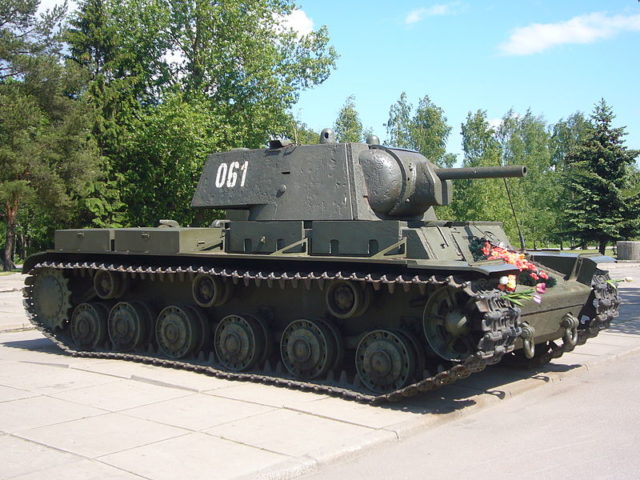
There are claims that the Soviet super tank never went into production while some claim that it participated in battles around Moscow and Leningrad in 1942. The Germans allegedly called it “The Stalin’s Orchestra” for it featured three turrets, one of which had rocket launching pods.
Krupp was almost given a carte blanche for his designs by Hitler, so he went one step further. They proposed the designs of the Landkreuzer P.1500 “Monster” ― a huge, mobile, self-propelled siege cannon, similar to the likes of their WWI designs. It was, basically, the Schwerer Gustav on tracks.
Nevertheless, it was an armament race between two bitter rivals and the Krupp company gained green light on June 23, 1942, to develop designs for the future tank. About that same time, Ferdinand Porsche, the automotive industry magnate, proposed the plans for the Maus, which was considerably smaller but easier to make.
In some sense, the Maus was a predecessor of Landkreuzer. Even though Speer cancelled both Landkreuzer projects in 1943, the Rat’s revival depended on the effectiveness of the Mouse.
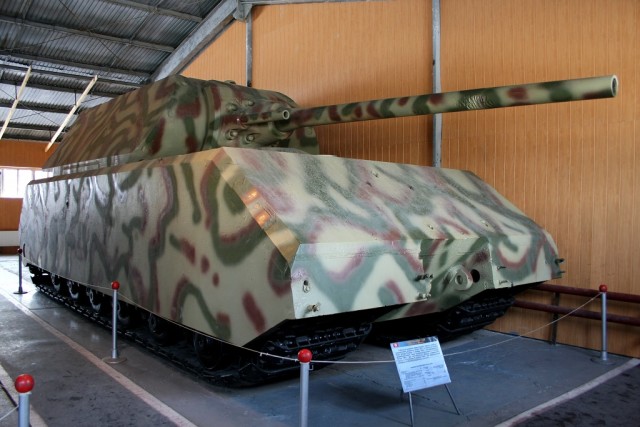
In 1944, two prototypes of the Maus tank were built, only one of them with the turret. The war was all but lost for the Germans by that time and their fanatical belief in producing a game-changing weapon didn’t really fit in with their remaining financial and industrial capacity.
By the time the Maus was operational, the prototype was already seized by the Soviets. In its short operational phase, Maus showed some serious defects concerning the tank’s ammunition storage under the turret which caused additional damage to the prototype. The tank is currently on display in the Kubinka Tank Museum in Russia.
The Landkreuzer project remained grounded, as Speer managed to finally convince Hitler with solid arguments that the tank was useless. Its large size would have rendered it unable to cross bridges, and travelling on roads would soon destroy them.
Its intended top speed was 40 kilometres per hour, resulting in a slow, highly visible tank, vulnerable to air bombardment and artillery fire, despite having heavy armour. Issues with transporting the vehicle to the battlefield were also prominent. No railway could bear the weight, and the width would be too large for any railway or tunnel to accommodate.
